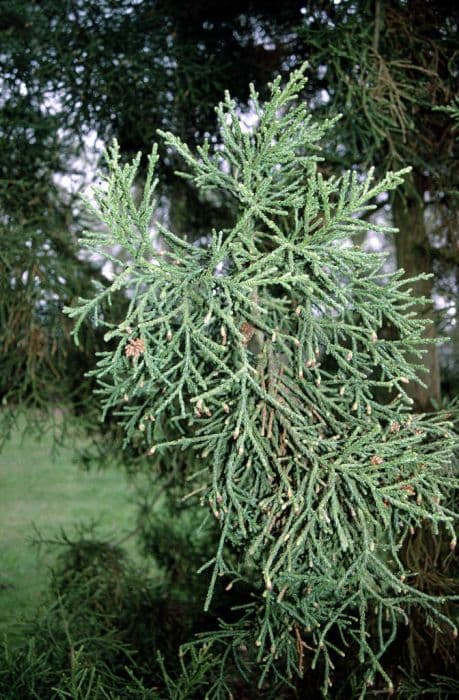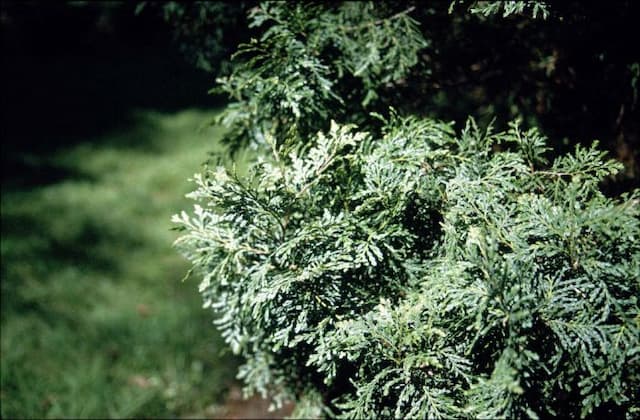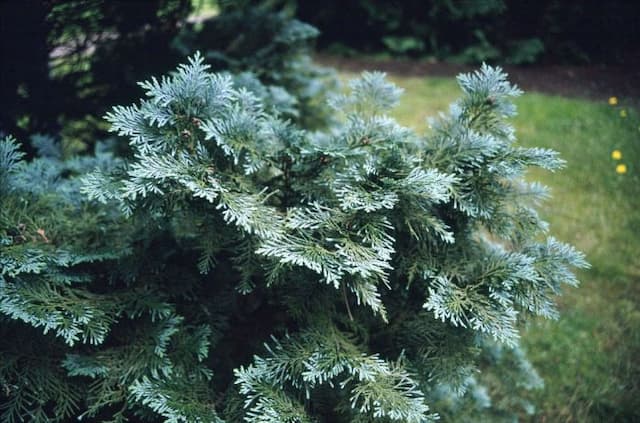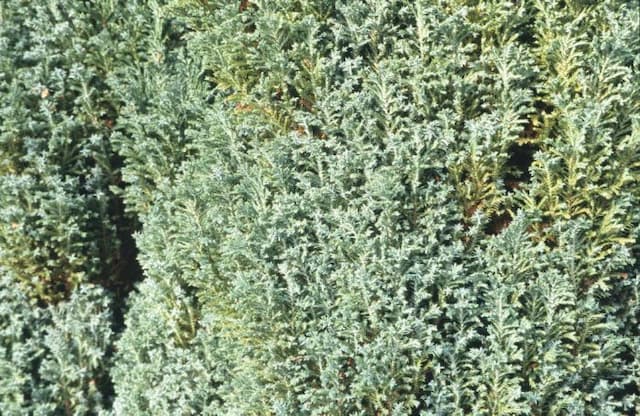Lawson Cypress Chamaecyparis lawsoniana 'Triomf van Boskoop'











ABOUT
The Chamaecyparis lawsoniana 'Triomf van Boskoop', commonly known as Lawson's cypress or Port Orford cedar, is a coniferous evergreen with a distinctive and attractive appearance. This plant boasts dense, feathery foliage that has a fine, soft texture. The leaves are arranged in flat sprays with a variation of green hues that may shift in intensity with the seasons, sometimes exhibiting bluish or yellowish tints. The foliage typically presents itself in an elegant weeping form, with branches that droop gracefully. The tips of the new growth can show a lighter, almost golden color, providing a lovely contrast against the darker, mature leaves deeper within the plant. Lawson's cypress is known for its conical shape that tapers to a point at the top, creating a pyramid-like silhouette that stands out in any garden setting. The bark is another notable feature, being fibrous with a reddish-brown color, which can peel or shred naturally as the plant matures. In terms of reproductive structures, this variety produces small, inconspicuous cones that may not be readily noticeable against the dense foliage. These cones, when present, are usually brown and woody, adding a subtle textural interest to the plant. Overall, the 'Triomf van Boskoop' cultivar is admired for its lush foliage, elegant shape, and the serene ambiance it lends to landscapes, making it a cherished choice among gardeners and landscapers who seek an evergreen with both beauty and poise.
About this plant
 Names
NamesFamily
Cupressaceae.
Synonyms
Lawson Cypress, Oregon Cedar, Port Orford Cedar.
Common names
Cupressus lawsoniana, Chamaecyparis lawsoniana, Cupressus lawsoniana var. inversa, Cupressus macrocarpa var. lawsoniana, Cupressus laevigata, Retinispora lawsoniana, Chamaecyparis ericoides, Chamaecyparis lawsoniana var. inversa, Chamaecyparis lawsoniana var. intermedia, Chamaecyparis lawsoniana var. lobbii, Chamaecyparis lawsoniana var. viridis, Chamaecyparis lawsoniana var. erecta, Chamaecyparis lobbii, Chamaecyparis thurifera.
 Toxicity
ToxicityTo humans
The plant commonly known as Lawson's Cypress is not frequently reported as being toxic to humans. However, like many conifers, it could potentially cause gastrointestinal discomfort if ingested in significant amounts due to the presence of various plant compounds. Additionally, some individuals might experience skin irritation or allergic reactions from handling the foliage. It is always advisable to exercise caution and avoid ingesting any parts of ornamental plants due to potential unknown toxicities.
To pets
Lawson's Cypress is not commonly listed as a toxic plant for pets. Nevertheless, ingestion of plant material could result in gastrointestinal upset for animals such as dogs and cats, leading to symptoms like vomiting or diarrhea. As with any non-food plant, it is wise to prevent pets from ingesting the leaves or any other parts of the plant to avoid potential adverse reactions. If a pet does consume significant quantities of the plant and shows signs of distress, it is recommended to consult a veterinarian.
 Characteristics
CharacteristicsLife cycle
Perennials
Foliage type
Evergreen
Color of leaves
Green
Height
10-15 feet (3-4.5 meters)
Spread
4-6 feet (1.2-1.8 meters)
Plant type
Tree
Hardiness zones
5
Native area
North America
Benefits
 General Benefits
General Benefits- Aesthetic Appeal: The Lawson Cypress 'Triomf van Boskoop' adds visual interest to landscapes with its distinctive, pyramid shape and its soft, feathery foliage.
- Evergreen Nature: As an evergreen, it provides year-round color and structure to gardens, offering a constant backdrop for seasonal plants.
- Windbreak: When planted in rows, it can act as a windbreak, protecting gardens and homes from strong winds.
- Privacy Screen: Its dense growth habit makes it an excellent natural screen for privacy around property lines or to hide unsightly views.
- Habitat for Wildlife: Provides shelter and nesting sites for birds, as well as a habitat for beneficial insects.
- Erosion Control: The plant's root system helps stabilize soil on slopes, reducing the risk of soil erosion.
- Low Maintenance: Once established, it requires minimal care, being drought tolerant and relatively resistant to pests and diseases.
- Versatility: Suitable for a variety of landscape uses including specimen planting, hedging, and topiary.
 Medical Properties
Medical PropertiesThis plant is not used for medical purposes.
 Air-purifying Qualities
Air-purifying QualitiesThis plant is not specifically known for air purifying qualities.
 Other Uses
Other Uses- The Lawson cypress 'Triomf van Boskoop' wood can be carved into intricate designs for decorative art pieces or practical objects like kitchen utensils.
- Shavings from the wood are sometimes used in packaged gourmet products to impart a mild woody aroma to foods like artisan cheeses.
- Thin slices of the wood may be used as a unique canvas for pyrography artists, offering a distinct grain pattern for their creations.
- The dense foliage can serve as a natural screen for privacy in gardens or to block unsightly views.
- When pruned into shape, the Lawson cypress can be used in topiary gardens, forming all sorts of artistic or geometric shapes.
- The branches and foliage can be harvested for use in floral arrangements, especially during the winter months for holiday decorations.
- Wood from the tree can be crafted into small, aromatic closet or drawer sachets to naturally repel moths and freshen up spaces.
- The sawdust from the wood, with its pleasant scent, can be used in smoking food to provide a unique flavor element to meats and fish.
- Large, felled branches can be hollowed out and used as natural-looking enclosures for outdoor lighting fixtures in landscape design.
- Dried out and properly treated, small sections of the branches can be used as a natural base for mounting various types of succulents or air plants.
Interesting Facts
 Feng Shui
Feng ShuiThe Lawson's Cypress is not used in Feng Shui practice.
 Zodiac Sign Compitability
Zodiac Sign CompitabilityThe Lawson's Cypress is not used in astrology practice.
 Plant Symbolism
Plant Symbolism- Longevity: The Chamaecyparis lawsoniana, commonly known as the Lawson's Cypress, is an evergreen conifer which symbolizes longevity due to its potential to live for hundreds of years.
- Endurance: As a hardy tree that can withstand various climate conditions, Lawson's Cypress represents endurance and the ability to persist through challenges.
- Protection: With its dense foliage and towering presence, this plant is often associated with providing shelter and protection, symbolizing safety and security.
- Peace: The evergreen nature of the Lawson's Cypress and its association with tranquil forests can symbolize peace and tranquility.
- Healing: Historically, some cypress species have been associated with healing due to their aromatic oils, and by extension, Lawson's Cypress can symbolize health and recuperation.
 Water
WaterLawson's Cypress 'Triomf van Boskoop' prefers consistent moisture but does not tolerate standing water, so ensure it is watered thoroughly but allowed to dry slightly between waterings. As a general rule, water deeply once a week, providing about 2 gallons per watering for an established plant in average conditions. Increase frequency during hot, dry periods to twice per week, and reduce in cooler, wetter months. Avoid overhead watering to prevent diseases, and instead, water at the base of the plant.
 Light
LightLawson's Cypress 'Triomf van Boskoop' thrives in full sun to partial shade. It does best with at least six hours of direct sunlight but can tolerate some light afternoon shade. Avoid deeply shaded locations as this may result in poor growth and sparse foliage.
 Temperature
TemperatureLawson's Cypress 'Triomf van Boskoop' is hardy and can tolerate a range of temperatures, surviving minimums down to 0°F while thriving in areas with temperatures between 60°F and 70°F. However, it is important to protect the plant from harsh winter winds which can cause damage to the foliage.
 Pruning
PruningPrune Lawson's Cypress 'Triomf van Boskoop' primarily to shape it or to remove dead or damaged branches. The best time for pruning is in early spring before new growth starts. Light pruning can be done throughout the growing season, but avoid heavy pruning which can cause harm to the plant.
 Cleaning
CleaningAs needed
 Soil
SoilLawson Cypress prefers well-draining soil with a mix of loam, peat, and sharp sand. The ideal pH range for this conifer is slightly acidic to neutral, between 5.0 and 7.0. A good recipe would be 1/3 loam, 1/3 peat moss, and 1/3 sharp sand to ensure proper drainage and support root health.
 Repotting
RepottingLawson Cypress, being a slow-growing tree, does not require frequent repotting. Young trees may be repotted every 2-3 years. For mature specimens, repotting is generally done every 4-5 years to refresh the soil and encourage continued growth.
 Humidity & Misting
Humidity & MistingLawson Cypress thrives outdoors in a naturally humid environment. The best humidity range for this conifer is between 40% to 60%, which generally reflects average outdoor conditions in its native habitat.
 Suitable locations
Suitable locationsIndoor
Place in bright light, ensure high humidity, and cool temps.
Outdoor
Plant in well-drained soil, full sun/partial shade.
Hardiness zone
5-8 USDA
 Life cycle
Life cycleLawson's Cypress 'Triomf van Boskoop' starts its life cycle as a seed, which after undergoing dormancy breaks open upon receiving appropriate environmental cues such as warmth and moisture. The seed then germinates, producing a small seedling that establishes a root system and shoots that begin photosynthesis. As the plant enters the juvenile stage, it rapidly increases in both height and girth, developing the characteristic dense, coniferous foliage and a pyramidal shape. This stage can last several years, during which the plant matures and begins to produce cones — the mature female cones contain seeds, while the smaller male cones release pollen. Once pollinated, usually by wind, the female cones develop seeds, completing the reproductive cycle. Lawson's Cypress 'Triomf van Boskoop' is a long-lived plant and can continue its cycle, producing cones and seeds for many years once mature.
 Propogation
PropogationPropogation time
Spring-Early Summer
Propogation: The Lawson's Cypress 'Triomf van Boskoop', a cultivar of Chamaecyparis lawsoniana, is most commonly propagated by semi-hardwood cuttings. This practice is typically undertaken in the late summer, but can also be done from mid-autumn to late winter when the plant is not actively growing. To propagate, cuttings of about 4 to 6 inches (approximately 10 to 15 centimeters) are taken from current year’s growth. The lower leaves are removed, and the cut end of the cutting is often dipped in rooting hormone to encourage root development. The prepared cuttings are then inserted into a moist propagation medium, such as a mix of peat and perlite or sharp sand, ensuring that the foliage does not touch the surface to prevent rotting. The container with the cuttings is placed in a sheltered area with indirect light and kept consistently moist until roots have developed, which typically takes several weeks to a few months. Once rooted, the cuttings can be potted up individually and grown on until they are ready to be planted out.









